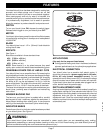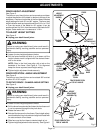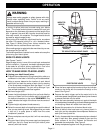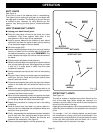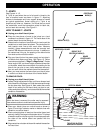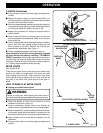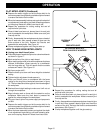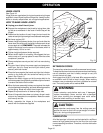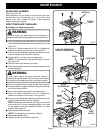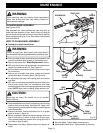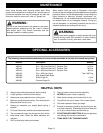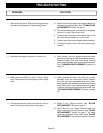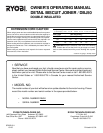
Page 16
OPERATION
Fig. 19
EXTENSION CORDS
The use of any extension cord will cause some loss of power.
To keep the loss to a minimum and to prevent tool overheating,
use an extension cord that is heavy enough to carry the
current the tool will draw.
A wire gage size (A.W.G.) of at least 16 is recommended for
an extension cord 50 feet or less in length. When working
outdoors, use an extension cord that is suitable for outdoor
use. The cord's jacket will be marked WA.
WARNING:
Check extension cords before each use. If damaged,
replace immediately. Never use tool with a damaged
cord since touching the damaged area could cause
electrical shock resulting in serious injury.
CAUTION:
Keep extension cords away from the cutting area and
position the cord so that it will not get caught on lumber,
tools, etc. during cutting operations.
LUBRICATION
All of the bearings in this tool are lubricated with a sufficient
amount of high grade lubricant for the life of the unit under
normal operating conditions. Therefore, no further lubrication
is required.
HINGE JOINTS
See Figure 19.
Hinge joints are used when joining two boards using hinges
supplied in one of Ryobi's optional hinge kits. Jewelry boxes,
doors on clocks, recipe boxes, etc. are typical applications.
HOW TO MAKE HINGE JOINTS
■ Unplug your detail biscuit joiner.
■ Prepare the workpieces to be joined by laying them side
by side on a workbench in the order in which they will be
hinged.
■ Determine the location of each hinge joint and mark the
center of each joint by drawing a line across each workpiece.
■ Set fence angle at 90°.
■ Loosen height adjustment knobs, then pull and slide the
fence down the scale until the height indicator mark is set
at zero depth of cut. REMEMBER: The scale indicates the
height of the fence from the center of the blade, which is
approximately .050 of an inch.
■ Tighten height adjustment knobs securely.
■ Select the #3 depth of cut setting. We suggest that you
make a test cut in a scrap piece of wood from the same
workpiece if possible.
■ Clamp workpiece securely so that it will not move during
the cut.
■ Plug your biscuit joiner into power supply and prepare to
make your first cut. Grasp and hold your biscuit joiner
securely with both hands.
■ Place the fence against the board and align the indicator
marks on the fence with the centerline mark(s) on the
board.
See Figure 19.
■ Depress the switch trigger and let the motor build to its
maximum speed, then gradually push biscuit joiner forward
to extend the blade into the wood.
■ When the base assembly bottoms out against the depth
of cut adjustment knob setting, pull back releasing pressure
on the spring. Blade will retract from hinge slot.
■ Repeat this procedure for all desired hinge slots.
■ Once all hinge slots have been cut, place a hinge in each
slot and dry assemble the workpieces. Make sure each
slot lines up and fits.
■ Finally, assemble the hinges to the workpieces and
secure with the fasteners supplied.
HINGE
SLOT(S)
HINGE
FASTENERS
HINGE



